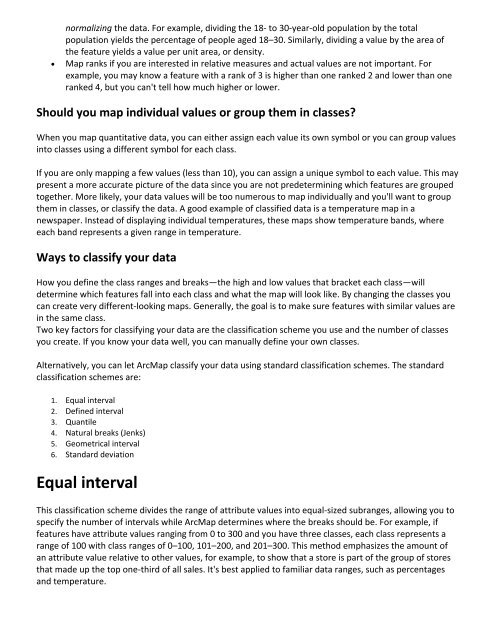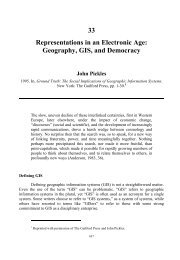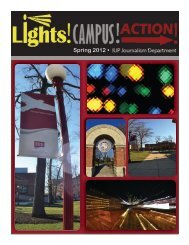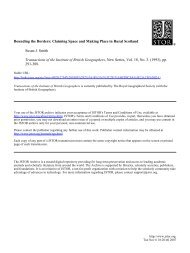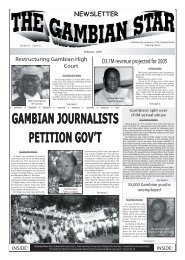Intro to GIS Exercise #5 – Symbology and Map Layout / Design IUP ...
Intro to GIS Exercise #5 – Symbology and Map Layout / Design IUP ...
Intro to GIS Exercise #5 – Symbology and Map Layout / Design IUP ...
Create successful ePaper yourself
Turn your PDF publications into a flip-book with our unique Google optimized e-Paper software.
normalizing the data. For example, dividing the 18‐ <strong>to</strong> 30‐year‐old population by the <strong>to</strong>tal<br />
population yields the percentage of people aged 18<strong>–</strong>30. Similarly, dividing a value by the area of<br />
the feature yields a value per unit area, or density.<br />
� <strong>Map</strong> ranks if you are interested in relative measures <strong>and</strong> actual values are not important. For<br />
example, you may know a feature with a rank of 3 is higher than one ranked 2 <strong>and</strong> lower than one<br />
ranked 4, but you can't tell how much higher or lower.<br />
Should you map individual values or group them in classes?<br />
When you map quantitative data, you can either assign each value its own symbol or you can group values<br />
in<strong>to</strong> classes using a different symbol for each class.<br />
If you are only mapping a few values (less than 10), you can assign a unique symbol <strong>to</strong> each value. This may<br />
present a more accurate picture of the data since you are not predetermining which features are grouped<br />
<strong>to</strong>gether. More likely, your data values will be <strong>to</strong>o numerous <strong>to</strong> map individually <strong>and</strong> you'll want <strong>to</strong> group<br />
them in classes, or classify the data. A good example of classified data is a temperature map in a<br />
newspaper. Instead of displaying individual temperatures, these maps show temperature b<strong>and</strong>s, where<br />
each b<strong>and</strong> represents a given range in temperature.<br />
Ways <strong>to</strong> classify your data<br />
How you define the class ranges <strong>and</strong> breaks—the high <strong>and</strong> low values that bracket each class—will<br />
determine which features fall in<strong>to</strong> each class <strong>and</strong> what the map will look like. By changing the classes you<br />
can create very different‐looking maps. Generally, the goal is <strong>to</strong> make sure features with similar values are<br />
in the same class.<br />
Two key fac<strong>to</strong>rs for classifying your data are the classification scheme you use <strong>and</strong> the number of classes<br />
you create. If you know your data well, you can manually define your own classes.<br />
Alternatively, you can let Arc<strong>Map</strong> classify your data using st<strong>and</strong>ard classification schemes. The st<strong>and</strong>ard<br />
classification schemes are:<br />
1. Equal interval<br />
2. Defined interval<br />
3. Quantile<br />
4. Natural breaks (Jenks)<br />
5. Geometrical interval<br />
6. St<strong>and</strong>ard deviation<br />
Equal interval<br />
This classification scheme divides the range of attribute values in<strong>to</strong> equal‐sized subranges, allowing you <strong>to</strong><br />
specify the number of intervals while Arc<strong>Map</strong> determines where the breaks should be. For example, if<br />
features have attribute values ranging from 0 <strong>to</strong> 300 <strong>and</strong> you have three classes, each class represents a<br />
range of 100 with class ranges of 0<strong>–</strong>100, 101<strong>–</strong>200, <strong>and</strong> 201<strong>–</strong>300. This method emphasizes the amount of<br />
an attribute value relative <strong>to</strong> other values, for example, <strong>to</strong> show that a s<strong>to</strong>re is part of the group of s<strong>to</strong>res<br />
that made up the <strong>to</strong>p one‐third of all sales. It's best applied <strong>to</strong> familiar data ranges, such as percentages<br />
<strong>and</strong> temperature.


